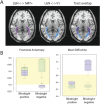Human blindsight is mediated by an intact geniculo-extrastriate pathway
- PMID: 26485034
- PMCID: PMC4641435
- DOI: 10.7554/eLife.08935
Human blindsight is mediated by an intact geniculo-extrastriate pathway
Abstract
Although damage to the primary visual cortex (V1) causes hemianopia, many patients retain some residual vision; known as blindsight. We show that blindsight may be facilitated by an intact white-matter pathway between the lateral geniculate nucleus and motion area hMT+. Visual psychophysics, diffusion-weighted magnetic resonance imaging and fibre tractography were applied in 17 patients with V1 damage acquired during adulthood and 9 age-matched controls. Individuals with V1 damage were subdivided into blindsight positive (preserved residual vision) and negative (no residual vision) according to psychophysical performance. All blindsight positive individuals showed intact geniculo-hMT+ pathways, while this pathway was significantly impaired or not measurable in blindsight negative individuals. Two white matter pathways previously implicated in blindsight: (i) superior colliculus to hMT+ and (ii) between hMT+ in each hemisphere were not consistently present in blindsight positive cases. Understanding the visual pathways crucial for residual vision may direct future rehabilitation strategies for hemianopia patients.
Keywords: blindsight; diffusion-weighted imaging; human; neuroscience; tractography.
Conflict of interest statement
The authors declare that no competing interests exist.
Figures









Comment in
-
Visual Plasticity: Blindsight Bridges Anatomy and Function in the Visual System.Curr Biol. 2016 Jan 25;26(2):R70-R73. doi: 10.1016/j.cub.2015.11.026. Curr Biol. 2016. PMID: 26811892 Free PMC article.
References
Publication types
MeSH terms
Grants and funding
LinkOut - more resources
Full Text Sources
Other Literature Sources

